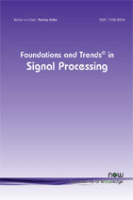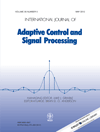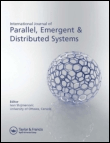
IEEE Transactions on Signal and Information Processing over Networks
Scope & Guideline
Exploring Breakthroughs in Networked Signal Processing.
Introduction
Aims and Scopes
- Distributed Signal Processing:
Research on algorithms and methodologies designed for processing signals across distributed networks, focusing on efficiency, scalability, and fault tolerance. - Networked Control Systems:
Study of control strategies and algorithms tailored for systems that operate over networks, addressing challenges like delays, packet loss, and security. - Optimization Techniques:
Exploration of optimization methods applicable to signal processing and networked systems, including decentralized and federated learning approaches. - Robustness and Security:
Investigations into resilient systems that can withstand adversarial attacks and maintain performance in the face of uncertainties and network failures. - Graph Signal Processing:
Research on methods for processing signals defined on graph structures, including applications in social networks, sensor networks, and communication networks.
Trending and Emerging
- Federated Learning and Privacy-Preserving Techniques:
An increasing focus on federated learning models that prioritize privacy and data security in distributed systems, reflecting growing concerns over data protection. - Robustness Against Cyber Attacks:
Research addressing the resilience of signal processing systems against cyber threats and attacks, particularly in the context of critical infrastructure and sensor networks. - Event-Triggered and Adaptive Control:
A rise in studies on event-triggered methods and adaptive control strategies that optimize communication and processing in dynamic environments. - Graph-Based Approaches:
Emerging research on graph signal processing techniques that leverage the structure of networks for better signal recovery and data representation. - Multi-Agent Systems and Consensus Algorithms:
A notable increase in the application of consensus algorithms in multi-agent systems, particularly in scenarios requiring cooperation under uncertainty.
Declining or Waning
- Traditional Centralized Approaches:
There is a noticeable shift away from centralized processing techniques as the focus moves towards distributed and decentralized methodologies, reflecting the evolving nature of networked systems. - Static Network Models:
Research concentrated on static or fixed network topologies is becoming less frequent, as dynamic and adaptive network models gain more relevance in current studies. - Basic Signal Processing Techniques:
Fundamental signal processing methods are being overshadowed by more complex, application-driven approaches that consider network effects and real-world constraints.
Similar Journals

Foundations and Trends in Signal Processing
Unveiling the latest trends in Signal Processing innovation.Foundations and Trends in Signal Processing is a premier academic journal published by NOW PUBLISHERS INC, specializing in the dynamic field of Signal Processing. With an impressive 2023 Q1 rank in its category and a notable position of 3rd out of 131 in the Scopus rankings for Computer Science and Signal Processing, this journal stands at the forefront of research dissemination in its domain. Established in 2007, it has provided a platform for high-quality research articles that cover cutting-edge topics and emerging trends in Signal Processing, which is critical for advancements in areas such as communications, image processing, and machine learning. Although the journal operates under a subscription model, it offers a wealth of vital information aimed at researchers, professionals, and students alike, fostering a robust academic dialogue and enhancing the knowledge base within this important field.

INTERNATIONAL JOURNAL OF ADAPTIVE CONTROL AND SIGNAL PROCESSING
Pioneering Research in Adaptive Control and Signal ProcessingINTERNATIONAL JOURNAL OF ADAPTIVE CONTROL AND SIGNAL PROCESSING, published by Wiley, is a premier peer-reviewed journal dedicated to the advancing field of adaptive control and signal processing. With a consistent publication history since 1987, this journal serves as a critical platform for disseminating innovative research and developments that contribute to both theoretical and practical aspects of engineering disciplines, specifically within the realms of control systems, electrical engineering, and signal processing. Boasting a commendable impact with quartile rankings in Q2 for Control and Systems Engineering, Electrical and Electronic Engineering, and Signal Processing, it ranks #93 among 321 journals in Control and Systems Engineering with a 71st percentile in Scopus rankings, underscoring its significance in fostering academic excellence. Although it does not offer open access, the journal is accessible through institutional subscriptions and individual purchases, promoting an extensive reach to researchers, professionals, and students eager to stay at the forefront of adaptive technologies. Whether seeking to explore cutting-edge methodologies or to gain insights into real-world applications, readers will find this journal to be an invaluable resource in the dynamic landscape of engineering innovation.

International Journal of Parallel Emergent and Distributed Systems
Advancing the Frontiers of Parallel Computing and Distributed SystemsInternational Journal of Parallel Emergent and Distributed Systems, published by Taylor & Francis Ltd, is a prestigious academic journal aimed at advancing the fields of parallel computing, distributed systems, and emergent technologies. With an ISSN of 1744-5760 and E-ISSN 1744-5779, this journal has been a vital resource for researchers and professionals since its inception in 2005. As a part of the Q3 category in Computer Networks and Communications and Q4 in Software, it reflects a growing interest and engagement in these critical areas of study, with Scopus rankings highlighting its significance in computer science. Although currently not an open-access journal, its comprehensive exploration of innovative methodologies, systems design, and distributed computing paradigms makes it essential reading for anyone involved in cutting-edge research and application development. The journal not only aims to disseminate novel insights but also serves as a platform to foster dialogue among practitioners and scholars alike, making it a cornerstone in the academic landscape of emergent technologies.

CIRCUITS SYSTEMS AND SIGNAL PROCESSING
Exploring Innovative Solutions in Systems and Signal ProcessingCIRCUITS, SYSTEMS AND SIGNAL PROCESSING, published by Springer Birkhauser, is a highly regarded journal in the fields of applied mathematics and signal processing, boasting an impact factor that reflects its robust academic contributions. Established in 1982, this journal aims to disseminate cutting-edge research that bridges the gap between theoretical advancements and practical applications in circuit design, systems theory, and signal processing. With a Thomason Scopus ranking of Q2 in Applied Mathematics and Q3 in Signal Processing, it stands out as a leading resource for researchers, professionals, and students seeking to enhance their knowledge and innovate within these disciplines. The journal provides insight into the latest trends and technologies, making it an essential reading for those engaged in the development of signal processing methodologies. Although it does not offer Open Access options, it remains a critical repository of knowledge with deep relevance in today's tech-driven landscape.

Journal of Signal Processing Systems for Signal Image and Video Technology
Connecting Ideas and Innovations in Signal Processing and Engineering.Journal of Signal Processing Systems for Signal Image and Video Technology, published by SPRINGER, is a leading interdisciplinary journal dedicated to advancing research and development in the fields of signal processing, image processing, and video technology. With an ISSN of 1939-8018 and an E-ISSN of 1939-8115, this journal emphasizes both theoretical and practical applications, boasting a wide scope that ranges from control and systems engineering to hardware architecture. Since its inception in 2008, it has gained a solid reputation, reflected in its 2023 category quartile rankings—including Q2 in Control and Systems Engineering and Q3 in Signal Processing—demonstrating its significance within the academic community. The journal is underpinned by a commitment to open access, promoting broad dissemination of knowledge, and is particularly vital for researchers, professionals, and students looking to contribute to and stay updated in these rapidly evolving fields. With ongoing explorations into the convergence of technology and methodology until 2024, the journal stands as a crucial resource for the latest innovations and discussions in signal processing systems.

DISTRIBUTED COMPUTING
Advancing the Frontiers of Distributed SystemsDISTRIBUTED COMPUTING is a prestigious journal published by SPRINGER that has been a significant contributor to the fields of computational theory, computer networks, and hardware architecture since its inception in 1986. With its ISSN 0178-2770 and E-ISSN 1432-0452, this scholarly publication stands out for its rigorous peer-review process and its commitment to advancing knowledge in distributed systems. The journal has consistently ranked in the Q1 category for multiple relevant domains, reflecting its high impact within the academic community. Although not an open-access journal, DISTRIBUTED COMPUTING offers essential insights and research contributions that are invaluable to researchers, professionals, and students alike. Its scope encompasses various aspects of computational theory and mathematics, ensuring a comprehensive approach to the complexities of distributed systems. With an address in New York, USA, and a delivery timeline extending to 2024, this journal is poised to continue influencing the landscape of computer science and beyond.

Journal of Electronics & Information Technology
Exploring Cutting-edge Developments in ElectronicsJournal of Electronics & Information Technology, published by the prestigious Chinese Academy of Sciences, Institute of Electronics, stands as a vital resource in the field of Electrical and Electronic Engineering. With an ISSN of 1009-5896, this journal has been dedicated to the dissemination of advanced research and innovative applications since its inception in 2001. It holds a competitive position within its category, ranked Q3 in the 2023 Scopus database, reflecting its contribution to the scientific community. The journal addresses a wide array of topics related to electronics and information technology, making it indispensable for researchers, professionals, and students aiming to stay at the forefront of technological advancements. Although it operates under a traditional model of access, its cumulative output remains pivotal for knowledge sharing and innovation in the rapidly evolving landscape of electronic engineering. With its commitment to excellence, the Journal of Electronics & Information Technology aims to foster a thriving academic environment and promote impactful research within the discipline.

International Journal of Electronics and Telecommunications
Connecting Ideas, Inspiring ResearchWelcome to the International Journal of Electronics and Telecommunications, a prominent publication dedicated to the evolving fields of electronics, telecommunications, and computer networks. Established by the Polska Akademia Nauk (Polish Academy of Sciences), this journal is committed to fostering academic research and technological advancements within these crucial domains. As of 2023, it holds a Q4 ranking in both Computer Networks and Communications and Electrical and Electronic Engineering, showcasing its role as a platform for emerging ideas and groundbreaking studies. With an Open Access model implemented since 2013, it enhances the visibility and accessibility of its articles, encouraging a broader impact and collaboration among researchers, professionals, and students alike. The journal serves as an important resource for those interested in the intersection of technology and communications, and it continues to contribute to the academic dialogue surrounding these vital sectors.

Frontiers in Communications and Networks
Advancing the Future of Digital CommunicationFrontiers in Communications and Networks is a prominent open-access journal published by FRONTIERS MEDIA SA, established in 2020 and positioned in the heart of Switzerland. As an interdisciplinary platform, it focuses on advancing research related to computer networks, communications, and signal processing, providing a critical forum for innovative findings and developments in these rapidly evolving fields. With an impressive Q1 ranking in Computer Networks and Communications and a Q2 ranking in Signal Processing as of 2023, this journal is highly regarded among scholars and practitioners seeking to disseminate their work to a broad audience. By offering open-access options, it ensures that the research is widely available, fostering collaboration and knowledge sharing across the globe. Researchers, professionals, and students are encouraged to engage with the journal as it aims to encapsulate the burgeoning advancements shaping our digital communication landscape.

Science China-Information Sciences
Shaping the Future of Computer Science Research.Science China-Information Sciences is a prestigious academic journal published by SCIENCE PRESS, dedicated to advancing knowledge in the field of information sciences and computer science. Established in China, the journal has gained a remarkable reputation, with a 2023 category quartile ranking of Q1 in Computer Science (miscellaneous) and an impressive Scopus rank of #16 out of 232 in General Computer Science, positioning it within the 93rd percentile. The journal embraces a broad spectrum of topics, from theoretical frameworks to practical applications, providing a platform for researchers, professionals, and students to disseminate their findings and engage with the latest advancements in the field. With open access options available, Science China-Information Sciences ensures that innovative research is accessible to a global audience, fostering collaboration and interdisciplinary dialogue. The journal not only reflects the evolving landscape of information sciences but also plays a pivotal role in shaping future research directions.